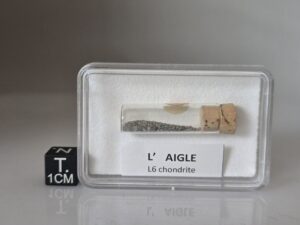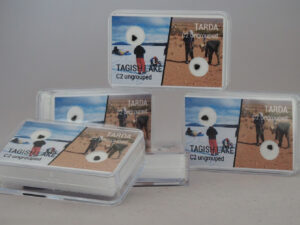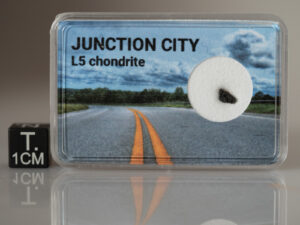Description
Junction City 32°38.2482’ N, 84°24.9576’ W
Georgia, United States
Confirmed fall: 2022 Sept 26
Classification: Ordinary chondrite (L5)
History: (P. Branch, M. Hankey) At 00.04 local time on 26 September 2022 (0404 UTC), a bright fireball traveling from the S to N detonated above southern Georgia between Atlanta and Columbus. This fireball was widely seen across the southeastern US with 66 reports to the American Meteor Society (event #6491-2022). Two cameras from the AMS ALLSKY7 Network operated by Ed Albin captured the fireball. ALLSKY7 Network camera operator Pat Branch placed the fall around Buckner Crossroads 4 km NE of Junction City, Talbot County, Georgia. Mr. Branch, Mr. Albin, and fellow hunter Carl Dietrich headed to the fall zone. Mr. Branch found the first stone 29 hours after the fall in the middle of Charles Buckner Rd, ~5.5 km NE of Junction City. A 91 g fusion-crusted fragment was sitting in an indentation in the road and surrounded by 79 g of fragments. Over the next few days, Ed Albin, Carl Dietrich, Ari Machiz, Illiana Machiz, Lance Schrumpf, Dave Lacco, Roberto Vargas, Mark Lyon, Sean Keeton, Rob Keeton, Matthew Stream, Michael Kelly, Ray Borges, Mike Buckner, and Derik Bowers found 582.8 g of fragments associated with the first find, for a total of 752.8 g in and around the same area. Eight more stones were subsequently found (see Geography section). All were found on or near the roads. The stones defined an ~7 × 1.4 km strewnfield trending SE to NW.
Physical characteristics: The stones are blocky with broad regmaglypts. Fusion crust is matte to glossy. Interior of the stones are bright white, lacking shock veins, and crumbly.
Petrography: (L. Garvie, ASU) A 2.4 g fragment was taken from the 159 g stone and prepared as a 1″ round polished mount. Optical and scanning electron microscopy show an abundance of chondrules, chondrule fragments, and mineral grains interspersed with metals and troilite. Many chondrules show sharp boundaries with the surrounding minerals. Chondrules up to 1.2 mm, dominated by PO and BO with a mean diameter of 550 microns (n=18). One BO chondrule is mantled by a thick igneous rim of polycrystalline olivine. Feldspar outside of the chondrules shows a range of sizes, some grains to 70 μm though the majority <25 μm. Kamacite to 500 μm, anhedral, some with holly-leaf-shaped margins. The kamacite is dominantly single crystal with curvy to linear Neumann bands that often exhibit a pinched profile. Taenite/tetrataenite to 350 µm and tends to be more equant than the kamacite. Etched taenite/tetrataenite commonly exhibit dark plessitic cores. Troilite is anhedral, to 400 µm, single crystal and lacking shock lamellae. Elemental copper is rare occurring as ~20-µm-sized grains associated with troilite/taenite. Accessory minerals include chromite to 300 μm and abundant scattered Ca-Cl and Ca-Na-Mg phosphates to 0.5 mm.
Geochemistry: (L. Garvie, ASU) Olivine Fa24.88±0.39, range Fa24.05-25.75, mean Cr2O3=0.03 wt%, FeO/MnO=48.07±2.44, n=19. Low Ca-pyroxene Fs21.04±0.13Wo1.61±0.29, mean Cr2O3=0.10 wt%, TiO2=0.15 wt%, and Al2O3=0.13 wt%, FeO/MnO=28.59±1.66, n=14. High Ca-pyroxene (one grain) Fa8.25Wo44.34, Cr2O3=0.76 wt%, TiO2=0.43 wt%, and Al2O3=0.149 wt%, FeO/MnO=32.82.
Classification: Ordinary chondrite, L5, S2, W0.
Specimens: 20.8 g at ASU





